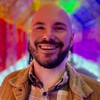“Christopher Street Liberation Day Gay-In,” offset flyer,1970; Charles Thorpe Papers (1987-02), GLBT HistoricalSociety.
San Francisco Gay Pride Program, 1972; EphemeraCollection, GLBT Historical Society.
The Gay American Indians contingent at the 1978 SanFrancisco Gay Freedom Day Parade; photo by Elaine Gay Jarvis, Elaine Gay Jarvis Photographs (2018-90), GLBT Historical Society.
A contingent of deaf LGBTQ people at the 1978 San FranciscoGay Freedom Day Parade; photo by Elaine Gay Jarvis ,Elaine Gay Jarvis Photographs(2018-90), GLBT Historical Society.
